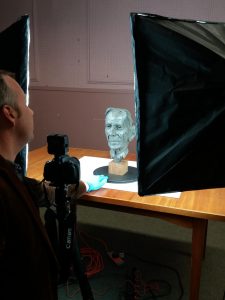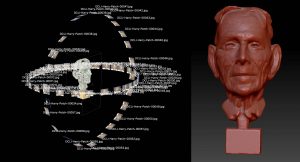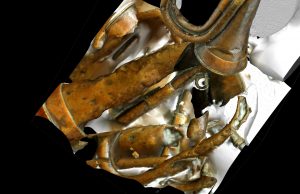Thanks to a grant from Cornwall Museums Partnership (CMP) we were able to commission Tom Goskar, from the Curatorial Research Centre to produce 10 3D scans of objects from our museum displays. The objects give a glimpse in to the variety of objects within our collections, which tell the stories of the Duke of Cornwall’s Light Infantry (DCLI) and Light Infantry (LI) and their precursor regiments.
You can investigate the collection on the Museum’s Our Collections pages.

Tom Goskar in action
The range of objects picked enabled us to tell the stories of the everyday. From the uniforms specifically designed to suit the varying environments the soldiers were fighting in to the equipment they used. From the mementos created by them, to those brought home from conflict zones, the objects chosen give an overview of the collections held by the museum. Due to issues around the physical accessibility of our museum, the use of the grant to get these scans done will enable those who otherwise would not be able to access the museum to do so.
3D scanning of objects, is not a simple process. It involves taking numerous (it can be hundreds!) or images of every angle of an object. Software then knits these images together, using a digital mesh, to fit the best images to the object to make it complete.

The image above of the bust of Harry Patch surrounded by photos shows the image capture path, how Tom ‘surrounds’ the object with photos in order to get good 3D coverage. The image on the right is the models being “retopologized” (their digital surfaces being reordered) which shows their form without any surface colour.
The process means that there are some objects that are just too difficult to photograph. An iconic visual identifier of our regiment is a bugle, and though we tried, even the least shiny of our bugles was a no go. Because of the light shining of reflective objects, and reflections themselves, the software just couldn’t make a whole object (despite how much tweaking Tom did).

The bugle after processing!
They weren’t the only objects difficult to process, those of very dark wood, like our Boer War carved objects, proves too difficult as does anything with feather or hair. With a collection full of shiny silver, bugles, medals, dark wooden objects, helmets with feather and hair, it narrowed down the field of what was possible, but we are so pleased with the results of what we have, which capture the essence of our collections.

